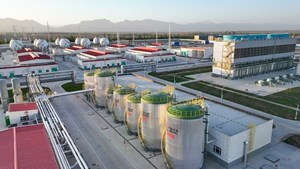News
China's 10,000-t photovoltaic green hydrogen pilot project fully built and put into production
(PRNewswire)—China Petroleum & Chemical Corporation (Sinopec) completed the construction of the Sinopec Xinjiang Kuqa green H2 pilot project, China's largest photovoltaic green H2 production project. It is put into operation to produce 20,000 tpy of green H2 at full capacity, a significant breakthrough in China's scaled industrial applications of green H2.
The green H2 produced by the project will supply to Sinopec Tahe Petrochemical to replace the existing natural gas and fossil energy used in H2 production, realizing the low-carbon development of modern oil processing and green H2 coupling.
The project is China's first large-scale utilization of photovoltaic power generation to produce green H2 directly. Utilizing the abundant solar resources in Xinjiang, the project has an electrolyzed water H2 plant with a capacity of 20,000 tpy, a spherical H2 storage tank with a H2 storage capacity of 210,000 sm3, and H2 transmission pipelines with a capacity of 28,000 sm3h. The project, as the first scaled application of green H2 refining, is expected to reduce CO2 emissions by approximately 485,000 tpy. Sinopec has tackled multiple bottlenecks, including flexible H2 production under the scenario of new energy power fluctuation, and achieved localization of major equipment and core materials.
With a focus on H2 transportation and green H2 refining, Sinopec is accelerating its H2 development with the establishment of more than 100 H2 refueling stations, owning and operating the largest number of H2 refueling stations in the world to date.
In the field of green H2 refining, Sinopec has been vigorously advancing centralized wind power and photovoltaic development, laying out mega-scale projects integrating renewable energy power generation, H2 production, storage and utilization.
In addition to the project, Sinopec's green H2 project in Ordos, which will produce 30,000 tpy began construction in February 2023, while the Ulanqab project is now in the planning stage. Toward the dual-carbon goals, Sinopec is committed to reducing carbon emissions and continually supporting and promoting green, low-carbon development.


